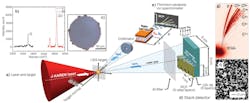Can graphene and an intense laser open up a new realm of extreme laser plasma physics?
A group of researchers from Japan and Taiwan recently achieved direct energetic ion acceleration by irradiating a target made of the world’s thinnest, strongest material—graphene—with an ultra-intense laser (J-KAREN) at the Kansai Photon Science Institute in Japan.
Theory shows that a thin target is required for higher ion acceleration, but it’s notoriously difficult to directly accelerate ions in an extremely thin target regime because noise components in the light from an intense laser destroy the targets before the main peak of the laser pulse arrives.
“We’ve been working on a laser-driven ion acceleration with intense lasers, and when I wanted an ion beam for electromagnetic field diagnostics for a laboratory astrophysics experiment, one of my colleagues warned me of a serious problem: radioactive contamination of the target chamber when they’d shot a relatively thick target,” says Yasuhiro Kuramitsu, an assistant professor at Osaka University’s Institute of Laser Engineering.
Just add graphene
Normally, researchers use lead to stop radiation from the laser-target interactions. In this case, they were dealing with “a relatively small laser system built within the physics department, which was already using many lead blocks for the electron acceleration experiment,” Kuramitsu adds. “But the floor couldn’t tolerate any more weight.”
So they set out to suppress the radiation itself. “The radiation comes from interactions between hot electrons heated by the intense laser and the nuclei within the target material,” says Kuramitsu. “We needed to reduce the number of nuclei and target thickness.”
The solution came in the form of graphene, which happens to be the thinnest 2D material. Monolayer graphene is transparent, highly electrically and thermally conductive, lightweight, and ideal for laser-driven ion sources.
One day while Kuramitsu and Wei-Yen Woon, a researcher who specializes in graphene, were waiting in line for their daughters at kindergarten, Kuramitsu asked him: “Can you make a free-standing large-area graphene?” Woon said it would be easy and he’d bring a large, suspended graphene (LSG) sample over.
“To date, graphene has a variety of applications, including in transportation, medicine, electronics, and energy,” says Woon. “We were able to demonstrate another disruptive application of graphene within the field of laser-ion acceleration, in which the unique features of graphene play an indispensable role.”
The researchers accomplished this via the J-KAREN ultra-intense short-pulse laser used with an optical parametric chirped-pulse amplifier (OPCPA) and a short-focal-length off-axis parabolic mirror (OAP) tight-focus beam, which results in an intensity of ~1022 W/cm2 (see figure). They were stunned to realize energetic protons and carbon ions at such a high intensity—without requiring a plasma mirror irradiating the graphene targets. A plasma mirror is usually necessary to remove noise components.
Direct irradiation of LSG targets generates MeV protons and carbon ions from subrelativistic to relativistic laser intensities, from low- to high-contrast conditions without a plasma mirror. This demonstrates how durable graphene is.
“No one believed the results at first glance, even some of our collaborators,” Kuramitsu notes. “Laser plasma physics researchers aren’t familiar with graphene.”
Pre-pulses and pedestals always accompany an intense laser pulse; these destroy the thin targets before the arrival of the main pulse. “Normally, a double-plasma mirror is necessary to remove the pre-pulse and pedestal when an extremely thin target is irradiated by an intense laser,” Kuramitsu explains. “We conducted many experiments with different types of lasers, and we realized graphene is quite different from 3D materials we normally use for laser targets.”
While the researchers’ work shows extremely high carbon-ion energies, they still don’t understand how the carbon ions are accelerated. “We believe graphene and the intense laser are opening up a new realm of extreme laser plasma physics,” says Kuramitsu. “We’re also planning to use graphene as a mount to accelerate other materials that can’t be suspended by themselves, such as extremely thin metals, nanostructure targets, and so on.”
Their findings may help develop compact and efficient laser-driven ion accelerators for cancer therapy, laser nuclear fusion, high-energy physics, and laboratory astrophysics.
The researchers published their initial work in Scientific Reports, and say they will share more results soon.
About the Author
Sally Cole Johnson
Editor in Chief
Sally Cole Johnson, Laser Focus World’s editor in chief, is a science and technology journalist who specializes in physics and semiconductors.

